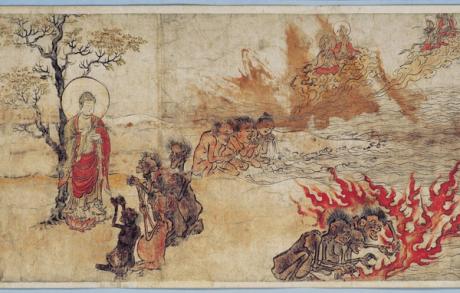
The last book I reviewed with this title was by the historian Simon Schama. It was tied to a 2006 documentary series in which Schama applied his gimlet stare to a series of big hitters in the Western tradition—Rembrandt, Caravaggio, Bernini, David. Viewers were treated to lingering close-ups of scumbled canvases, knobbly impastos, crisp chiaroscuro, marble made dimpled flesh. It was all watchable enough. But the chief lesson to be drawn from it—one which subsequent culture pundits from Grayson Perry to David Olusoga have failed to heed—is that men of a certain age ought to be circumspect about wearing a leather jacket on camera.Caroline Campbell takes a broader view. Her book is a whistle-stop tour of nigh-on four millennia of human creative activity, from Babylon to Pyongyang. Powerful, influential individuals do crop up, from Michelangelo sending his servant out to the Tuscan equivalent of Tesco’s with a famous pictographic shopping list, to Shah Jahan sipping from his white jade wine-cup and conjuring up the most magical monument to grief ever devised, to Helen Frankenthaler battling to be taken seriously on the macho New York art scene and devising a more or less entirely new painting process more or less (though not entirely) by accident.This impressive work looks beyond the white world and the male gaze in an easy-going and unpreachy waySome, like the Iyoba of Benin (the Cersei Lannister of early modern West Africa) or the Great Leader of the Democratic People’s Republic of North Korea are as it were transfigured into art, their lives and their depictions whisked up into one mighty hybrid. But the book’s rattling pace precludes much in the way of character development. Campbell’s leading players are cities, each one in turn considered as a nexus of various cultural forces over a particular period, and—in most but not all cases—as a crucible for pre-eminence in one particular form or mode of art.There’s much to admire along the way. The book is lucid, even and beautifully produced. It accomplishes the task of looking beyond the white world and the male gaze in an easy-going and unpreachy way. There is inevitably a slight flavour of 1066 and All That about some passages as we canter along. I was reminded of my daughter when she was small, stoppering her ears and bellowing “FACT ALERT!” as I tried to enlighten her about this picture or that building.Indeed, given so much of the book is offered up as fact, I’d like there to be fewer mistakes, or let’s say odd remarks. Donatello’s David isn’t the first post-classical male nude; duomo means cathedral not dome; we’re not sure quite what Gregory the Great’s jazzed-up restoration of the shrine of St Peter in the Vatican looked like, but it can’t have obscured the earlier free-standing shrine altogether, as there’s a ninth-century mosaic on the latter which the sampietrini would not have troubled themselves to execute if nobody had been able to look at it.I’m not sure, come to that, that we get a full enough sense of the way shame, as well as pride, stimulated lavish artistic patronage in Renaissance Florence. “Magnificence” might be a bad thing as well as a good one, especially if your money had been made in banking, and you therefore inevitably sailed close to the wind on the issue of usury, which definitely was a bad thing. Interestingly, it is in her treatment of African and Asian art, which would seem to lie further from her professional wheelhouse of the Italian Renaissance, that Campbell’s writing is at its most supple and alert, as in her consideration of the parallel development of calligraphy and picture-making in 11th-century Kyoto.Overall, as a feat of research and organisation, The Power of Art is a pretty impressive piece of work. Campbell is surely right to insist that the true power of art lies not in the semi-ritualised contemplation of a few hallowed masterpieces but in how fully interwoven with our lives certain types of image and object are. Ideas and materials—cobalt-glazed ceramic, still life, the heroic figure, the notion of a brushstroke as a kind of emotional and spiritual fingerprint—echo down the centuries and take wing around the world. Art (defined broadly, at any rate), is the water we swim in; we should pay more mind to it.• Caroline Campbell, The Power of Art: A World History in Fifteen Cities, the Bridge Street Press, 512pp, £30 (hb), published 12 October 2023• Keith Miller is an editor at The Telegraph and a regular contributor to the Literary Review and The Times Literary Supplement




















